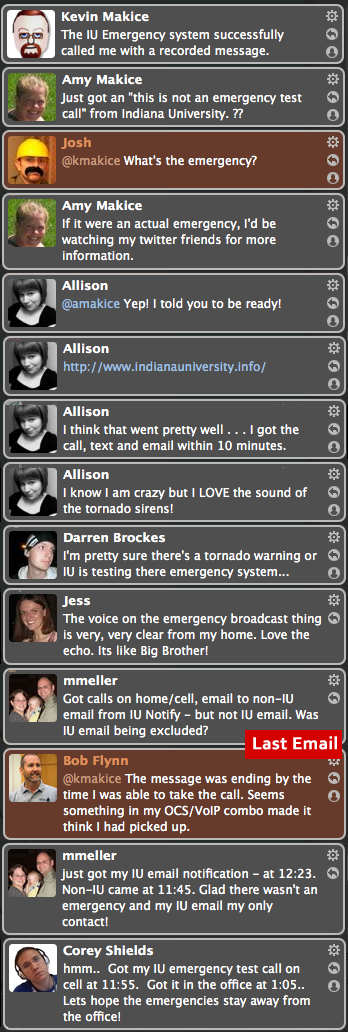On Friday, Indiana University tested its emergency notification channel. Like other universities, this system is largely a response to the tragic shootings on the Virginia Tech campus a year ago.
IU-Notify was first tested last December, a couple months after Purdue conducted similar tests. IU-Notify allows students, faculty and staff to self-select which means of notification—if any—the University will use to communicate emergency situations that are an immediate threat to the community. Thanks to a reminder tweet from a friend, I made sure my information was updated for the test.
I got my cell phone call at 11:42a on Friday. The system also called my home number. Ten minutes later, my personal email address received the test message. Twenty minutes after that, my IU email got a notice, not long after sirens sounded and a booming voice informed the campus of the faux emergency.
In that span, there were eleven tweets in my Twitter stream related to the system test.

On Friday, Indiana tested the IU-Notify emergency system
Of some concern is the gap in reporting. Without offering up my phone and personal email, I would have heard the sirens before getting the email, well after the start of the alert process. It is possible (even likely) that IU-Notify was purposely rolling notifications, and therefore nothing should be read into the gaps. Still, the purpose of such a system is not to showcase the engineering; it is to provide critical knowledge and reassurance that the official response is happening quickly.
What is an Emergency?
A half day after the test, IU-Notify was about to be put to use. A man reportedly assaulted some students on 17th street after midnight early Saturday morning. The injured parties had been to the hospital and talked to the police before someone pushed the button to send a “cautionary message” to the campus community.
Clearly, this first real test of the system was not well received.

IU-Notify was quickly put to the test
Someone from my Twitter network wondered if the system will also be used “to notify us about passed out undergrads laying on sidewalks after tailgating all day.”
There are about 300 known local Twitter users, about half of which represent the transient population of students. Even with a small (but growing) footprint, Twitter was the first point of notification last October when a “sniper” gunned down some law books from atop a west side apartment building. Although that incident turned out to be minor, Bloomington and campus officials certainly would have been able to use IU-Notify to disseminate information about the rerouted bus lines and provide situational updates until the immediate danger decreased.
As frightening as an assault is, unless it is happening serially with a perceived immediate threat to more than isolated victims, it probably isn’t an emergency for IU-Notify. Sadly, there were 92 such assaults and 171 violent crimes in Bloomington in 2005. A case might be made for announcing attempted rapes, which have a greater propensity toward serial actions than assault, but even then there should be some fairly high bar for a threat to be disseminated with 5am text messages. The best use of IU-Notify might be to try not to use it.
The news of the attack is still fresh, so there is a chance that the notification was a good call, that someone now aware of the danger at large will be saved through that knowledge. However, even in that unlikely case, the notice came five hours after the attack during a time of day when the vast majority of people are asleep. What good could it possibly do?